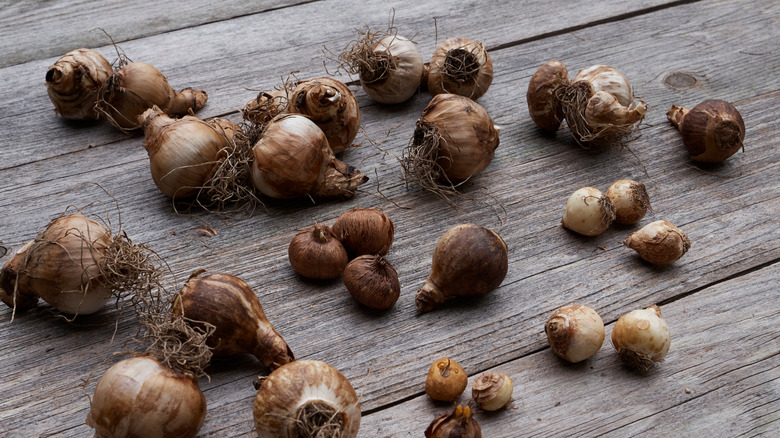The Essential Winter Gardening Task For Bulbs That Produces A Healthier Spring
When it comes to the yard, there is always so much to do in the fall. Between tidying up the leaves and prepping perennials for the colder months, it is easy to forget about the bulbs that are sitting snug in the soil. However, some tender bulbs will not survive the winter months, so you should dig up the cold-sensitive flowers to save for next season. Before digging them up, you must also find a suitable location to store them until spring comes around again.
Common tender bulbs that rarely survive over winter, like calla lilies, dahlias, caladiums, and elephant ear bulbs, need protection and should be dug up. Think about which bulbs are in your yard and do some research. It is always better to be safe than sorry! You can dig up tender bulbs once the foliage has died back or been killed by the first frost. The first frost will usually kill the tender top growth, but the bulbs themselves should be okay. Dig them up soon after the foliage has died, since leaving them too long can cause rot. Use a fork and carefully dig around the bulb, taking care not to damage any roots. Begin a few inches away from the bulb, moving in slowly. Once you have loosened the bulb, shake off any excess soil.
How to store tender bulbs for spring
After removing the bulbs from your garden, clean the remaining soil off the roots with a hose. Examine the bulbs' health and discard any that are damaged or diseased. Once washed, the bulbs need to be dried before they are stored. Lay the bulbs out of direct sunlight in a well-ventilated location that stays at room temperature. Most bulbs need 1 to 3 days of drying before being placed in storage, but some, like calla lilies, may need longer. Turn the bulbs a few times per day to help them dry fully.
You can store bulbs in sawdust, wood shavings, peat moss, sand, or vermiculite, placing them in cardboard boxes or paper bags in two or three layers. It is helpful to label the boxes or bags so you know what you're planting in the spring. Avoid airtight containers for your bulbs, and don't let the individual bulbs touch one another. Once they are all packed away, place them in a cool, dark, dry location that maintains a temperature between 35 and 45 degrees Fahrenheit, such as in your unheated garage, shed, or basement. The bulbs should not be stored in an area where the temperature dips below freezing.
Keep an eye on your bulbs over the winter period and remove any that begin to rot or decay. If they look shriveled, the sawdust or sand they're stored in may need to be moistened with a spray bottle. If they seem too moist, however, you may need to take them out of storage and air them out. When the threat of frost has passed, you can divide these plants in spring and place them back in your garden for fresh blooms.

